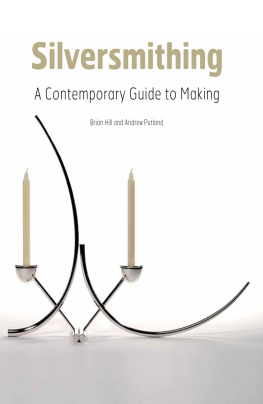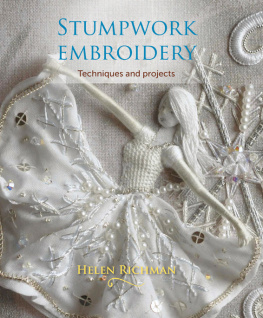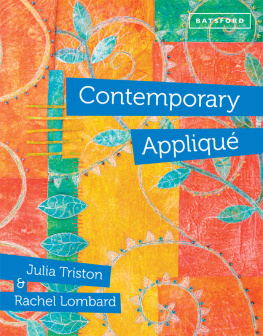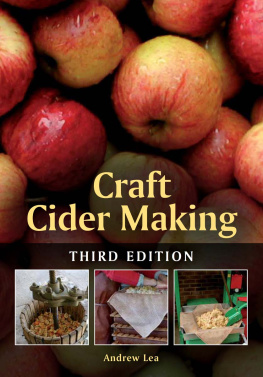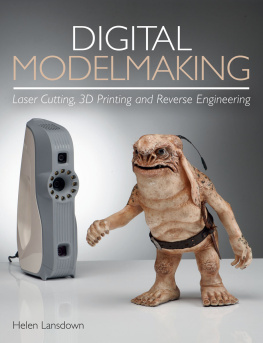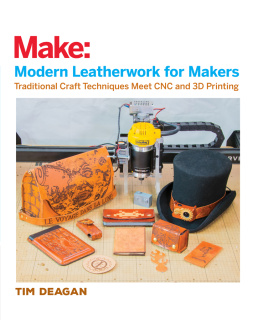
First published in 2014 by
The Crowood Press Ltd
Ramsbury, Marlborough
Wiltshire SN8 2HR
www.crowood.com
This e-book first published in 2014
Brian Hill and Andrew Putland 2014
All rights reserved. No part of this publication may be reproduced or transmitted in any form or by any means, electronic or mechanical, including photocopy, recording, or any information storage and retrieval system, without permission in writing from the publishers.
British Library Cataloguing-in-Publication Data
A catalogue record for this book is available from the British Library.
ISBN 978 1 84797 616 1
Acknowledgments
The authors have enjoyed the high spirit of liaison and collaboration from the industry in compiling this book. In particular we thank The Goldsmiths Company and The Goldsmiths Centre for their incredible and invaluable support. With special thanks to Eleni Bide, David Beasley, Alison Byne, Robert Organ, Rosemary Ransom Wallis, Gerry Tiling and Richard Valencia.
Live visits to workshops at The Goldsmiths Centre have been crucial in capturing manufacturing techniques that feature throughout the book. Our appreciation and gratitude extends to John Need, Reg Elliot, Alan Fitzpatrick, Sam Marsden and James Neville for their expert help and assistance.
The computer illustrations bridge theory and practice, generated and crafted by Richard Gamester, and we thank him for his significant contribution.
In the substantial image commentary has been generously supported by photographer Lee Robinson, we thank him for his contribution.
Our thanks also go to the Goldsmiths Craft and Design Council for the use of some images.
Cover images
Front cover: Brett Payne, XY candlesticks.
Frontispiece
Silver chandeliers by Padgham and Putland, using a stainless steel skeleton. Commissioned by Prime Development Ltd and Nicola Bulgari.
CONTENTS
INTRODUCTION
The unique craft of silversmithing has managed to survive the passage of time; its traditional skills, techniques and processes are still relevant for practising silversmiths in the twenty-first century. For modern silversmiths, particularly the self-employed, this is an exciting and rewarding time to be engaged in this popular area of the precious metals specialist crafts. Designers continue to demonstrate creative expression and individuality through their three-dimensional work, whether focusing on conventional, skills-based techniques or harnessing new production and technological advances. The collective outcome guarantees that there is something appealing, distinctive and attractive for everyones attention, appreciation and admiration.
The primary aim of this book is to inform, inspire, encourage and direct those who wish to learn more about the practical craft of silversmithing, whether they are students, enthusiasts or designers. Additionally, it can serve as a useful compendium for practising silversmiths. The book has a strong vocational and practical ethos, aimed at guiding readers through a hands-on, step-by-step approach that encourages interested parties to have a go and become experiential learners.
The books central remit and intention is to relay the traditional making aspects of the craft in a contemporary context, alongside the more recent technological advances. These advances offer stimulating opportunities for designers and makers to develop, increase and enhance their portfolio of skills, experience and overall capabilities.
The number and palette of designer-makers engaged in silversmithing increases year on year and the abundance of outlets for self-employed practitioners continues to grow. A high percentage of these designer-makers have taken the college/university route of training, and the book is very much addressed to this vibrant population, who will benefit from its vocational stance, practical advice and emphasis on the value of education.
The historical section highlights some important and striking examples of hand-craft and production skills employed on pieces of silverware; these leave us in awe of the skills and abilities of former craftspeople.
It is possible to engage in meaningful silversmithing within humble surroundings using a basic set of tools and equipment. The early chapters detail this starting point before moving on to more involved workshops for business, relating to established companies and the self-employed. There are many ways to make costs bearable and sustainable when setting yourself up: for example, communal group workshops are popular and economically viable. As well as the financial benefits that sharing resources provides, the supportive culture and working ethos that come with it encourage and accelerate learning in this type of community.
Of course it needs to be remembered that even with an extensive range of tools, equipment and machinery at your disposal, without the fundamental origins of skill-based learning, everything becomes harder and takes longer to achieve. It is these core and essential skills that everything else revolves around and emanates from. There is no substitute for these inherent craft skills and the resulting confidence and experience will serve you well as you develop your own interests, style, direction and subsequent career pathway.
Manufacturing techniques and methods along with production processes take centre stage in this book, to help engender skills-based learning as a basis for promoting the traditional methods of making, which remain irreplaceable. They hold the key to successful, high-quality making of a professional standard, and serve as an excellent foundation from which all other things evolve, develop, progress and prosper.
The many decorative treatments that are available to the silversmith extend a range of visual qualities to designs, offering greater levels of contrast and impact. Allied aspects of the craft, such as chasing, engraving and enamelling, are excellent examples that give form, detail, colour, refinement and enrichment. The chapter on surface decoration illustrates the significant contribution that these forms of decoration can provide on larger-scale work.
Over recent years computer aided design (CAD) has developed to a point where it is now difficult to separate the real from the virtual. This challenging and pioneering period has seen a substantial shift towards design, particularly the rendering of large-scale work, and this area of rapid progression in silversmithing is an important aspect for inclusion in the book.
For some time, rapid prototyping has been the logical extension from CAD and this is now widely used in the construction of domestic and ecclesiastical products, models and artefacts, and in some cases has revolutionized the way parts can be accurately produced. Additionally, the use of laser and TIG welding has offered positive assistance to the silversmith and this technological development needs to be recorded, utilized and celebrated widely as we seek to improve our capabilities and calibre of work.
The chapters on designers in industry and designer-makers profile an extensive and diverse range of technical processes and aesthetic styles. There is such depth and breadth of activity in silversmithing that the entire book could easily have been taken up by portraying some of the many gifted designers and their varied and beautiful work.
Next page
